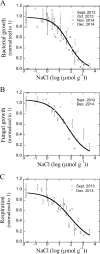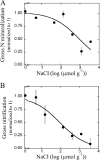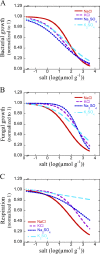Comparative Toxicities of Salts on Microbial Processes in Soil
- PMID: 26801570
- PMCID: PMC4807522
- DOI: 10.1128/AEM.04052-15
Comparative Toxicities of Salts on Microbial Processes in Soil
Abstract
Soil salinization is a growing threat to global agriculture and carbon sequestration, but to date it remains unclear how microbial processes will respond. We studied the acute response to salt exposure of a range of anabolic and catabolic microbial processes, including bacterial (leucine incorporation) and fungal (acetate incorporation into ergosterol) growth rates, respiration, and gross N mineralization and nitrification rates. To distinguish effects of specific ions from those of overall ionic strength, we compared the addition of four salts frequently associated with soil salinization (NaCl, KCl, Na2SO4, and K2SO4) to a nonsaline soil. To compare the tolerance of different microbial processes to salt and to interrelate the toxicity of different salts, concentration-response relationships were established. Growth-based measurements revealed that fungi were more resistant to salt exposure than bacteria. Effects by salt on C and N mineralization were indistinguishable, and in contrast to previous studies, nitrification was not found to be more sensitive to salt exposure than other microbial processes. The ion-specific toxicity of certain salts could be observed only for respiration, which was less inhibited by salts containing SO4(2-) than Cl(-) salts, in contrast to the microbial growth assessments. This suggested that the inhibition of microbial growth was explained solely by total ionic strength, while ion-specific toxicity also should be considered for effects on microbial decomposition. This difference resulted in an apparent reduction of microbial growth efficiency in response to exposure to SO4(2-) salts but not to Cl(-) salts; no evidence was found to distinguish K(+) and Na(+) salts.
Copyright © 2016, American Society for Microbiology. All Rights Reserved.
Figures



Similar articles
-
Investigating the long-term legacy of drought and warming on the soil microbial community across five European shrubland ecosystems.Glob Chang Biol. 2013 Dec;19(12):3872-84. doi: 10.1111/gcb.12338. Epub 2013 Oct 10. Glob Chang Biol. 2013. PMID: 23897832
-
Contrasting soil pH effects on fungal and bacterial growth suggest functional redundancy in carbon mineralization.Appl Environ Microbiol. 2009 Mar;75(6):1589-96. doi: 10.1128/AEM.02775-08. Epub 2009 Jan 16. Appl Environ Microbiol. 2009. PMID: 19151179 Free PMC article.
-
Changes in water-extractability of soil inorganic phosphate induced by chloride and sulfate salts.Environ Sci Pollut Res Int. 2008 Jan;15(1):23-6. doi: 10.1065/espr2006.06.309. Environ Sci Pollut Res Int. 2008. PMID: 18306884
-
Growth of saprotrophic fungi and bacteria in soil.FEMS Microbiol Ecol. 2011 Oct;78(1):17-30. doi: 10.1111/j.1574-6941.2011.01106.x. Epub 2011 Apr 28. FEMS Microbiol Ecol. 2011. PMID: 21470255 Review.
-
The normalcy of dormancy: common themes in microbial quiescence.Cell Host Microbe. 2013 Jun 12;13(6):643-51. doi: 10.1016/j.chom.2013.05.012. Cell Host Microbe. 2013. PMID: 23768489 Free PMC article. Review.
Cited by
-
Biogeographical Patterns and Assembly of Bacterial Communities in Saline Soils of Northeast China.Microorganisms. 2022 Sep 5;10(9):1787. doi: 10.3390/microorganisms10091787. Microorganisms. 2022. PMID: 36144389 Free PMC article.
-
Photoinactivation of Staphylococci with 405 nm Light in a Trachea Model with Saliva Substitute at 37 °C.Healthcare (Basel). 2021 Mar 11;9(3):310. doi: 10.3390/healthcare9030310. Healthcare (Basel). 2021. PMID: 33799642 Free PMC article.
-
Application of Magnetized Ionized Water and Bacillus subtilis Improved Saline Soil Quality and Cotton Productivity.Plants (Basel). 2024 Sep 2;13(17):2458. doi: 10.3390/plants13172458. Plants (Basel). 2024. PMID: 39273942 Free PMC article.
-
Soil amendments with ethylene precursor alleviate negative impacts of salinity on soil microbial properties and productivity.Sci Rep. 2019 May 3;9(1):6892. doi: 10.1038/s41598-019-43305-4. Sci Rep. 2019. PMID: 31053834 Free PMC article.
-
Responses of the Soil Microbial Community to Salinity Stress in Maize Fields.Biology (Basel). 2021 Oct 29;10(11):1114. doi: 10.3390/biology10111114. Biology (Basel). 2021. PMID: 34827107 Free PMC article.
References
-
- Martinez-Beltran J, Manzur CL. 2005. Overview of salinity problems in the world and FAO strategies to address the problem, p 311–314. In Proceedings of the International Salinity Forum, Riverside, CA.
-
- Szabolcs I. 1989. Salt-affected soils. CRC Press, Boca Raton, FL.
-
- Six J, Frey SD, Thiet RK, Batten KM. 2006. Bacterial and fungal contributions to carbon sequestration in agroecosystems. Soil Sci Soc Am J 70:555–569. doi:10.2136/sssaj2004.0347. - DOI
Publication types
MeSH terms
Substances
LinkOut - more resources
Full Text Sources
Other Literature Sources
Medical

